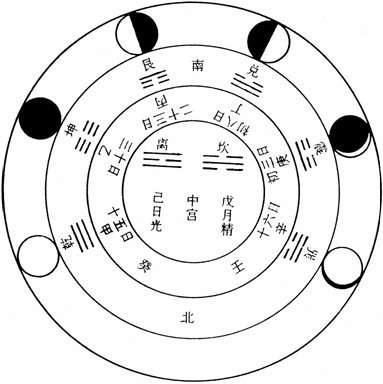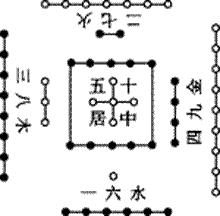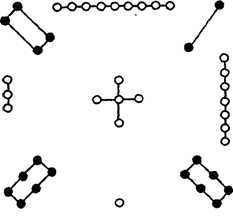On 30 th Oct. 2007, Pro, Liu Dajun was invited to attend Ⅱ Symposium on Sinology & Ⅶ Immersion in Cosmoethics (
Jinan
) and delivered his lecture on “An Introduction to the Zhouyi” as following:
An Introduction to the Zhouyi
一 Categories in the Zhouyi
(一)The Three Meanings of the Yi
(二)The Two Parts in the Book of the Zhouyi
(三)Different Schools in the Zhouyi Studies
(四)Terms in the Zhouyi Studies
二 The Historical Development of the Zhouyi Studies
(一)Yi-ology in the pre-Qin Dynasty
(二)Yi-ology in the Han & Wei Dynasties
(三)Yi-ology in the Tang Dynasty
(四)Yi-ology in the Song & Ming Dynasties
(五)Yi-ology in the Qing Dynasty
一 Categories in the Zhouyi
(一)The Three Meanings of the Yi
The first meaning of Yi is the ease and simplicity of Yi, which means that the Zhouyi applies the simple symbol of eight trigrams to reflect the complex world including the natural world and the human society.
Xi Ci Ⅰ(Appended Comments) says, “It is by the ease with which it proceeds that Qian directs (as it does), and by its unhesitating response that Kun exhibits such ability.”
The second meaning is the changes. The Zhouyi is a book which mainly elaborates the theory of changes. Zhouyi, also called Yi, is known in English as: (1) Canon of Changes; (2) Changes of Zhou; (3) Classic of Change; (4) Book of Change; (5) I Ching; (6) Zhou Book of Change. Most of these translated names contain the meaning of change.
It was believed in Shuo Wen Jie Zi《说文解字》, the Origin of Chinese Characters (the earliest Chinese dictionary by Xu shen 许慎of the Eastern Han Dynasty), that the character of Yi易 is the combination of the characters of Ri(日the sun)and Yue(月the moon)in which the up half structural part of the character of 易is the Ri日 and the down part is Yue月. The character of Yi易 symbolizes the opposition, interaction and transformation between the Ri (yang) and Yue (yin),which are the most notable images between the heaven and earth. The Zhouyi mainly elaborates the theory for the movement and changes of the sun and the moon.
The third meaning is permanence. The eight trigrams symbolize the complex world reflecting that there are some permanent rules, also called Dao, of the nature and human world for us to obey. The Dao of the world are not changed.
(二)The Two Parts in the Book of Zhouyi
There are two main parts in the Zhouyi: the Ancient Text and the Commentaries (interpretations by the later-generation scholars).
In the Ancient Text, also called Gu jing古经, there are Sixty-four Hexagrams as follow:
1乾
Qian

|
2坤
Kun

|
3屯
Tun

|
4蒙
Meng

|
5需
Xu

|
6讼
Song

|
7师
Shi

|
8比
Bi

|
9小畜Xiao Xu

|
10履
Lü

|
11泰
Tai

|
12否
Pi

|
13同人Tong Ren

|
14大有Da You

|
15谦Qian

|
16豫
Yu

|
17随
Sui

|
18蛊
Gu

|
19临
Lin

|
20观Guan

|
21噬嗑Shi He

|
22贲
Bi

|
23剥
Bo

|
24复
Fu

|
25无妄Wu Wang

|
26大畜Da Xu

|
27颐
Yi

|
28大过Da Guo

|
29坎
Kan

|
30离
Li

|
31咸
Xian

|
32恒
Heng

|
33遁
Dun

|
34大壮
Da Zhuang

|
35晋
Jin

|
36明夷
Ming Yi

|
37家人
Jia Ren

|
38睽
Kui

|
39蹇
Jian

|
40解
Jie

|
41损
Shun

|
42益
Yi

|
43夬
Guai

|
44姤
Gou

|
45萃
Cui

|
46
升
Sheng

|
47困
Kun

|
48井
Jing

|
49革
Ge

|
50鼎
Ding

|
51震
Zhen

|
52艮
Gen

|
53渐
Jian

|
54归妹
Gui Mei

|
55丰
Feng

|
56旅
Lü

|
57巽
Xun

|
58兑
Dui

|
59涣
Huan

|
60节
Jie

|
61中孚
Zhong Fu

|
62小过
Xiao Guo

|
63既济
Ji Ji

|
64未济
Wei Ji

|
There are also the names of hexagrams and attached statements to them and lines.
The Commentaries, Yi zhuan 易传, also called the Ten Wings traditionally credited to Confucius (551-479 B.C.), including Tuan zhuan彖传(上、下) (Judgment) I and II, Xiang Zhuan象传(上、下) (Image) I and II, Xi Ci Zhuan系辞传 (Appended Comments) I and II, Wen Yan Zhuan文言传 (Commentary on hexagrams Qian
 and Kun
and Kun
 ), Shuo Gua Zhuan 说卦传(Commentary on the Trigrams), Xu Gua Zhuan序卦传 (The Orderly Sequence of the Hexagrams), and Za Gua Zhuan杂卦传 (Treatise on the Hexagrams Taken Promiscuously, According to the Opposition or Diversity of Their Meaning).
), Shuo Gua Zhuan 说卦传(Commentary on the Trigrams), Xu Gua Zhuan序卦传 (The Orderly Sequence of the Hexagrams), and Za Gua Zhuan杂卦传 (Treatise on the Hexagrams Taken Promiscuously, According to the Opposition or Diversity of Their Meaning).
(三)Different Schools in the Zhouyi Studies
For the schools are concerned, it is traditionally divided into two academic schools: image-number (象数,interpreting the Zhouyi by images and numbers), and Yi Li (义理, interpreting the Zhouyi with philosophical connotations implicated), philosophical school.
The image-number school came into being and primed in the Western Han Dynasty, which interprets the Dao of heaven (heavenly principle) by the Gua-qi theory (卦气说,a theory elucidating the correspondence between the Chinese seasonal points and lines of the hexagrams), explains the Text of the Zhouyi by the images of trigrams and hexagrams and elaborates the Yin-yang theory by divination.
The philosophical school, arising in the Western Han Dynasty and being in vogue in the Wei & Jin Dynasties, explains the Text by the literal meaning of the Commentaries (易传,Yi Zhuan), and stresses on the metaphysical implications.
(四)Terms in the Zhouyi Studies
Hu Ti Theory (Interlocking Trigrams)
Whereas a hexagram is composed of two trigrams and six lines, by the Hu Ti theory, the 2nd to the 4th line can form a new trigram, the 3rd to the 5th line can constitute a new trigram, called interlocking trigrams. By this way, more hexagrams can be derived in an original hexagram. Image-number scholars utilize this tradition to seek the correlation between the images and remarks affiliated to the hexagrams and lines.
The Theory for the Yin-yang's Waxing and Waning
In a hexagram, Yang yao's (undivided line) declining and Yin yao's (divided line) growing is called Xiao (消,waxing), whereas Yin yao's declining and Yang yao's growing is Xi 息(waning). Take the Fu hexagram 复(
 Returning) for example, as for the first line, Yang yao is growing while the Yin yao is waning which is Yi Yang Xi Yin (一阳“息”阴).
Returning) for example, as for the first line, Yang yao is growing while the Yin yao is waning which is Yi Yang Xi Yin (一阳“息”阴).
Na Jia Theory
In the Han Dynasty, the Yi-ologists of JING Fang and YU Fan inserted the ten heavenly stems into the trigrams or hexagrams and correlated the heavenly stems to five elements and five positions. Jia (甲) is the first one in the ten heavenly stems, so the theory is called Na Jia. By Chinese tradition, there are ten heavenly stems of Jia(甲), Yi(乙), Bing(丙), Ding(丁), Wu(戊), Ji(己), Geng(庚), Xin(辛), Ren(壬), Gui(癸). The ten heavenly stems were first used in the lunar calendar, symbolizing the waxing and waning of the moon in a lunar month, so the Na Jia theory depicts the correlation of the trigrams and the moon phases. In the Na Jia theory, Qian hexagram corresponds to Jia and Ren, Kun hexagram to Yi and Gui, Zhen to Geng, Xun to
Xin
,
Kan
to Wu, Li to Ji, Gen to Bing, Dui to Ding.
Ten Stems: Jia & Yi Bing & Ding Wu & Ji Geng & Xin Ren and Gui
Five Elements: Wood Fire Earth Metal Water
Five Positions: East South Center West North

(Na Jia Diagram 纳甲图)
Yao-chen Theory
Yao-chen (爻辰)theory is that correlating the twelve hexagram lines of Qian and Kun with the twelve earthly branches,which individually dominate the twelve months.
Hexagram Qian
The sixth line, undivided — Xu戌(the eleventh earthly branch) September
The fifth line, undivided — Shen申(the ninth earthly branch) July
The fourth line, undivided — Wu午 (the seventh earthly branch) May
The third line, undivided — Chen辰 (the fifth earthly branch) March
The second line, undivided — Yin寅( the third earthly branch) January
The first line, undivided — Zi子( the first earthly branch) November
(The undivided line is called Yang Yao, or Jiu (nine))
Hexagram Kun
The sixth line, divided -- Si 巳 (the sixth earthly branch) April
The fifth line, divided -- Mao卯(the fourth earthly branch) February
The fourth line, divided -- Chou丑( the second earthly branch) December
The third line, divided -- Hai亥( the twelfth earthly branch) October
The second line, divided -- You酉(the tenth earthly branch) August
The first line, divided -- Wei未(the eighth earthly branch) June
(The divided line is called Yin Yao, or Liu (six))
Gua Qi Theory
Gua Qi theory correlates the trigrams and the lines of hexagrams to the Chinese seasonal points as well as days. In the theory, hexagrams of
Kan
, Zhen, Li, Dui individually dominate the four seasons of winter, spring, summer and autumn, and the twenty-four lines of the four hexagrams correspond to the twenty-four seasonal points.
Timeline of the Hexagrams
Sixty-four hexagrams symbolize the continuous and endless changes of the universe. Each hexagram represents a step of the process, reflecting the change and rules of the some thing in a certain step, which is timeline.
River Map and Luo Chart
Legend has it that Fu Xi was vouchsafed the River Map河图 on the back of a dragon-like horse which emerged from a tributary of the Yellow River. Fu Xi was inspired by the chart to draw the eight trigrams as follow:

Legend says that the Luo Chart was drawn by Yu the Great, who found, in the
Luo
River
, a magical tortoise with a serious numbers on its back as follow:

He Tu and Luo Shu are disputed theories, though they are kept in many authoritative works of Zhouyi.
二 The Historical Development of the Zhouyi Studies
(一) Yi-ology in the pre-Qin Dynasty
In early of the Western Zhou Dynasty (A.D1046 – A.D 771), the Zhouyi was guarded by the divinatory officials and out of the touch of the common. It was at the Warring States period that the Zhouyi began spreading. Many scholars quoted the Text of the Zhouyi and elaborated their views.
Traditionally, the Commentaries《易传》, also called Ten Wings, is believed to be the works of Confucius who actually once interpreted the Zhouyi on the basis of the former learning, and his disciples recorded and arranged the materials into the main chapters of Yi Zhuan《易传》(the Commentaries) in the mid of the Warring States period.
(二) Yi-ology in the Han & Wei Dynasties
The works on the Zhouyi from the Yi-ologists in the Western Han Dynasty are the earliest materials we received now. Yi-ology in the Western Han Dynasty was passed down by TIAN He (田何). In the Han Dynasty, the theory for image-number was completed, such as Na Jia theory, Gua Qi theory and Yao-chen theory mentioned above. During the regime of Emperor Wu (汉武帝),Zhouyi was venerated as the top the five Confucian Classics, namely Yi Jing.
In the Wei & Jin Dynasties, the Yi-ologist, WANG Bi (王弼), stressing the philosophical idea in the Yi, established a philosophical metaphysical school, which took place of the Han tradition as a authority.
(三) Yi-ology in the Tang Dynasty
In the Tang Dynasty, KONG Yin-da (574 - 648 ), under orders of Emperor TAI Zong (唐太宗,599 - 649) compiled the Rectifications of Meanings of Zhouyi《周易正义》, in which mainly interpreting WANG Bi's Note to the Zhouyi and also deriving the ideas from the Han tradition.
Another famous compilation of Zhouyi is the Collected Annotations to Zhouyi by LI Ding-zuo (李鼎作), which is the most important reference for us to study Han Yi-ology. In the book, about thirty-five Yi-ologists' interpretations to Zhouyi are recorded, such as MENG Xi, JING Fang, ZHENG Xuan, YU Fan, WANG Bi and so on.
(四) Yi-ology in the Song & Ming Dynasties
The theories for the River Map and Luo Chart 河图洛书(mentioned above) are especially stressed in the Song Yi-ology. It is said that the River Map, Luo Chart and Prenatal Diagram (先天图) were passed down by a legendary Daoist priest, CHEN Tuan (陈抟,? - 988). Moreover, the Prenatal Diagram was expanded by SHAO Yong邵雍(1011 – 1077)to Huang ji Tu shuo 《皇极图说》( On the Grand Ultimate Diagram) and served an great influence on the development of later Yi-ology.
Another feature of the Song Yi-ology is to combine the Yi-ology with the Li理 (principle) school. Many conceptual categories of Li school came out of the annotation on the Zhouyi, such as Dao, Tai Ji, Yin-yang and so on.
(五) Yi-ology in the Qing Dynasty
In the beginning of the Qing Dynasty, the Song Yi-ology held a dominant position, whereas the Han tradition was attached importance as well. It is believed one of the most contributions that the Qing Yi-ologists' collation to the Han Yi and arrangement on former works of Yi-ology, mixing the Han tradition and the Song Yi during the regime of Emperor Kangxi康熙(1661 - 1722)and Qianlong乾隆(1735 - 1795). At the order of Emperor of Qianlong, Si ku Quan shu 《四库全书》 ( the Complete Library in the Four Branches of Literature) was compiled, of which many views on the former books should still be approved now.





